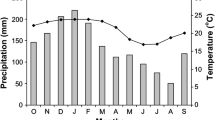Abstract
The phenology of 49 shrub species in five forest types occurring along an altitudinal gradient (350–2150 m) in Kumaun Himalaya has been studied. The evergreen leaf-exchanging taxa accounted for nearly half of the species, the remaining half was nearly equally divided between an evergreen continual leaf drop type and deciduous taxa. The percentage of species with lengthy leaf drop increased with elevation and finally leveled off. At each site the maximum leaf drop period coincided with the warm dry period. Percentage of species with multiple leaf flushing was low for all forests. The degree of extended leafing decreased with increasing elevation along which summer dryness also decreased. Earliest leaf initiation was observed for evergreen continual leaf drop species, followed by evergreen leaf-exchanging, and deciduous types.
For each forest, two peaks of flowering activity occurred, one during the warm dry period and the other in the warm wet period. The percentage of species with multiple flowering increased with increasing elevation. Nearly half of the species bore fleshy fruits. The mature fruit retention period for different forests ranged from about 2–3 months.
The proportion of deciduous species was similar in trees and shrubs; leaf drop was common during the summer season for trees, while it was common during the winter season for shrubs; the proportion of species with multiple leafings was greater and leaf initiation earlier in shrubs than trees; and generally shrubs showed two flowering peaks and trees only one.
Similar content being viewed by others
References
Beatley, J. C., 1974. Phenological events and their environmental triggers in Mojave desert ecosystems. Ecology 55: 856–863.
Frankie, G. W., Baker, H. G. & Opler, P. A., 1974. Comparative phenological studies of trees in tropical wet and dry forests in lowlands of Costa Rica. J. Ecol. 62: 881–919.
Lieth, H. (ed.), 1974. Phenology and Seasonality Modeling. Springer-Verlag. Berlin. Heidelberg. New York. 444 pp.
Loveless, A. R. & Asprey, G. F., 1957. The dry evergreen formations of Jamaica. I. The limestone Hills of the south coast. J. Ecol. 45. 799–822.
Murray, C. & Miller, P. C., 1982. Phenological observations of major plant growth forms and species in montane and Eriophorum vaginatum tussock tundra in Central Alaska. Holarctic Ecol. 5: 109–116.
Opler, P. A., Frankie, G. W. & Baker, H. G., 1980. Comparative phenological studies of treelet and shrub species in tropical wet and dry forests in the lowlands of Costa Rica. J. Ecol. 68: 167–188.
Osmaston, A. E., 1926. A forest flora for Kumaun. Intern. Book Distributors. Dehra Dun, 605 pp.
Ralhan, P. K., Khanna, R. K., Singh, S. P. & Singh, J. S., 1985. Phenological characteritics of the tree layer of Kumaun Himalayan forests. Vegetatio 60: 91–101.
Rao, P. B., Singh, R. P. & Singh, S. P., 1984. Regeneration of forest trees. In: An Integrated Ecological study of Eastern Kumaun Himalaya with Emphasis on Natural Resources (eds. J. S. Singh & S. P. Singh). Final report submitted to the Department of Science and Technology, New Delhi, India (2): 21–60.
Shimwell, D. W., 1972. The description and classification of vegetation. Univ. of Washington Press, Seattle. 322 pp.
Shukla, R. P. & Ramakrishanan, P. S., 1982. Phenology of trees in a subtropical humid forest in north eastern India. Vegetatio 49.
Singh, J. S., Lauenroth, W. K., Heitschmidt, R. K. & Dodd, J. L., 1983. Structural and functional attributes of the vegetation of northern mixed prairie of North America. Bot. Rev. 49(1): 117–149.
Singh, J. S. & Singh, S. P., 1984. An Integrated Ecological study of Eastern Kumaun Himalaya with Emphasis on Natural Resources. Kumaun University, Nainital, India. Final report submitted to the Department of Science and Technology, New Delhi; 2: 379 pp.
Tewari, J. C. & Singh, J. S., 1983. Application of aerial photoanalysis for assessment of vegetation in Kumaun Himalaya. I. Ranibagh to Naina peak-Kilbari. Proc. Indian Nat. Sci. Acad. B 49(4): 336–347.
Warming, E., 1909. Oecology of plants. An introduction to the study of plant communities. Oxford University Press, London. 422 pp. (Modified English edition of original Danish publication: Plantesamfund, 1895). 2nd Impr. 1925.
Author information
Authors and Affiliations
Additional information
Nomenclature follows Osmaston (1926).
Financial support from the Gaula Catchment Eco-development project and the Department of Science and Technology, Government of India, is gratefully acknowledged. We thank Dr. Y. P. S. Pangtey for his help in plant identification.
Rights and permissions
About this article
Cite this article
Ralhan, P.K., Khanna, R.K., Singh, S.P. et al. Certain phenological characters of the shrub layer of Kumaun Himalayan forests. Vegetatio 63, 113–119 (1985). https://doi.org/10.1007/BF00044061
Accepted:
Issue Date:
DOI: https://doi.org/10.1007/BF00044061




